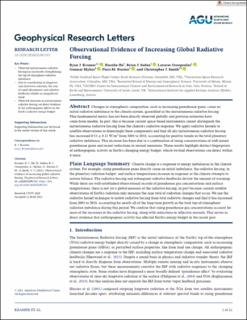| dc.contributor.author | Kramer, Ryan J. | |
| dc.contributor.author | He, Haozhe | |
| dc.contributor.author | Soden, Brian J. | |
| dc.contributor.author | Oreopoulos, Lazaros | |
| dc.contributor.author | Myhre, Gunnar | |
| dc.contributor.author | Forster, Piers M. | |
| dc.contributor.author | Smith, Christopher J. | |
| dc.date.accessioned | 2021-10-08T08:25:43Z | |
| dc.date.available | 2021-10-08T08:25:43Z | |
| dc.date.created | 2021-08-18T17:08:09Z | |
| dc.date.issued | 2021 | |
| dc.identifier.citation | Geophysical Research Letters. 2021, 48 (7), 1-11. | en_US |
| dc.identifier.issn | 0094-8276 | |
| dc.identifier.uri | https://hdl.handle.net/11250/2788616 | |
| dc.description.abstract | Changes in atmospheric composition, such as increasing greenhouse gases, cause an initial radiative imbalance to the climate system, quantified as the instantaneous radiative forcing. This fundamental metric has not been directly observed globally and previous estimates have come from models. In part, this is because current space-based instruments cannot distinguish the instantaneous radiative forcing from the climate’s radiative response. We apply radiative kernels to satellite observations to disentangle these components and find all-sky instantaneous radiative forcing has increased 0.53 ± 0.11 W/m2 from 2003 to 2018, accounting for positive trends in the total planetary radiative imbalance. This increase has been due to a combination of rising concentrations of well-mixed greenhouse gases and recent reductions in aerosol emissions. These results highlight distinct fingerprints of anthropogenic activity in Earth’s changing energy budget, which we find observations can detect within 4 years. | en_US |
| dc.language.iso | eng | en_US |
| dc.publisher | AGU | en_US |
| dc.rights | Navngivelse 4.0 Internasjonal | * |
| dc.rights.uri | http://creativecommons.org/licenses/by/4.0/deed.no | * |
| dc.title | Observational Evidence of Increasing Global Radiative Forcing | en_US |
| dc.type | Journal article | en_US |
| dc.type | Peer reviewed | en_US |
| dc.description.version | publishedVersion | en_US |
| dc.source.pagenumber | 1-11 | en_US |
| dc.source.volume | 48 | en_US |
| dc.source.journal | Geophysical Research Letters | en_US |
| dc.source.issue | 7 | en_US |
| dc.identifier.doi | 10.1029/2020GL091585 | |
| dc.identifier.cristin | 1927060 | |
| dc.relation.project | Norges forskningsråd: 250573 | en_US |
| cristin.ispublished | true | |
| cristin.fulltext | original | |
| cristin.qualitycode | 2 | |

